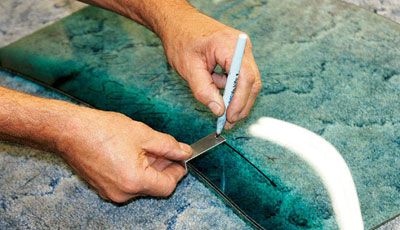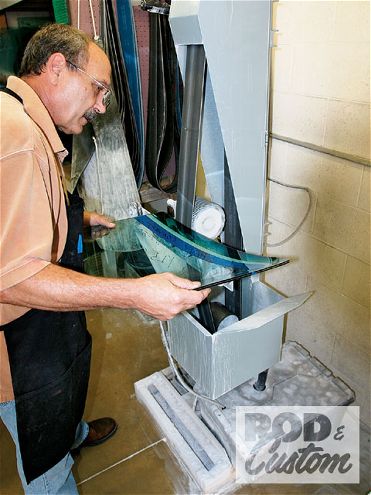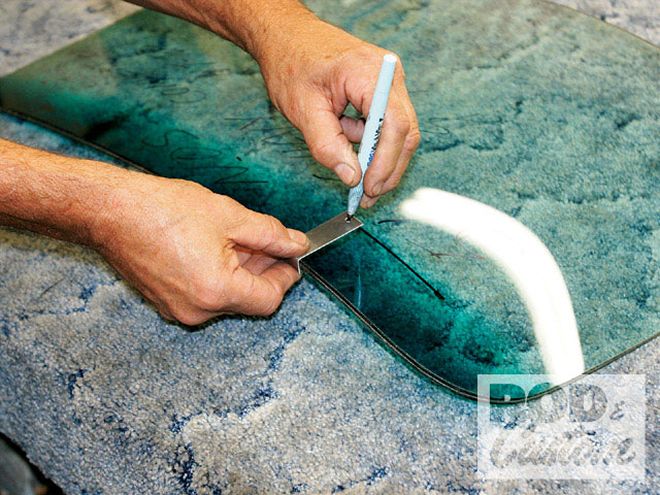

There are plenty of magazine articles on how to chop a roof- we've even got one in this issue- yet probably the most important piece of the jigsaw in putting the car back on the road is never mentioned. Glass. Just how do you go about cutting that down? And if it's curved, as most post-'48 windshields are, what's the trick to cutting 'em without breaking 'em?
Though it's rarely mentioned, it's always a good idea to cut the glass and then chop the car to suit, as metal (or fiberglass!) can be moved around, whereas glass is going to be the same shape, just shorter, or in thousands of pieces! It should also be considered that only laminated glass can be cut; toughened glass cannot. If the car you want to chop has toughened glass, and you can't source laminated replacements, your only option (well, apart from the hideously expensive manufacture of a one-off piece) may be to try to use glass from another make or model that's similar in shape and modify the car to accept that.
When I chopped my '49 Chevy for instance, it was before I moved to the U.S., and while replacement glass is available here, it would have been exorbitantly expensive by the time it reached England, and that was if it was still in one piece, so I made a fiberglass template from the one bullet-holed half of the windshield I did have, and then went around to parking lots laying it over windshields! Believe it or not, a section of the windshield from a curved glass VW Bug was almost exactly the same shape, enabling me to make the two halves of the Chevy windshield from two VW versions. The only modification was to the top outside corners of the body aperture, where the glass curved inward slightly more than the original. It saved me a bunch of cash and I had brand-new glass.
 Mike at The Glass House demonstrated how he chops curved windshields using this '51 Chevy glass. He made this neat little tool to mark the glass a consistent 3 inches down from the top edge.
Mike at The Glass House demonstrated how he chops curved windshields using this '51 Chevy glass. He made this neat little tool to mark the glass a consistent 3 inches down from the top edge.
Speaking of new glass, while photographing for this article at The Glass House, we asked proprietor Mike Cox whether old glass is perhaps more brittle than new glass. His opinion was that so long as it is in good condition, and the layers haven't started to separate, it should be no more brittle or harder to cut without breaking than new glass. Which is good news if your glass is in good condition and you want it cut down.
Flat laminated glass is relatively easy to cut, but curved glass is infinitely more tricky. We've seen it cut with varying degrees of success in the same manner as flat glass, by scribing it, breaking the glass, then heating and cutting the plastic laminate between the layers of glass, but the risk of breaking the glass when 'snapping' it along the scribelines is high because of the curve. Something to think about if your glass is rare or expensive. Mike prefers to sand the glass down to size on a large belt sander, and though this is time-consuming, the risk of breakage is minimal. On the '51 Chevy windshield half shown here, it took three hours to sand off 3 inches.
Cut It Yourself!
I was talking to Brad Masterson, who chopped the Chevy four-door on page 18 of this issue, about cutting down glass, and he told me that a friend of his had just cut his own '57 Chevy windshield using cheap diamond mini-cutting discs from his local discount tool supply house. If you're the do-it-yourself type and want to have a go at cutting your own glass, this could be the way to go. Not wanting to recommend something I hadn't tried myself, I grabbed a set of the aforementioned discs, and scrounged a piece of glass from a local supplier (The Glass Doctor in Temecula, California) and tried them for myself.
I really wanted to cut a windshield but didn't have one at hand, and couldn't scare up a cracked one in time (deadlines are like that!) so bearing in mind the only glass I could get at short notice was household plate glass and not automotive glass, the cutting discs worked very well. There was some chipping, but I'd put this down to the high speed of my nonadjustable cheapo electric mini-grinder, and it was nothing that couldn't be corrected when polishing or beveling the edge of the glass later. However, I would say this method would take as long as sanding the glass down, not to mention it'd be very nerve-racking, but it is an option. Oh, and if you go this route, take as many precautions as you can and then some. You don't want to be breathing fine glass dust, and there'll be a lot of it.